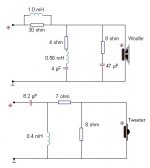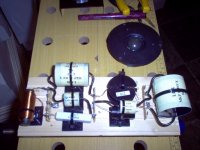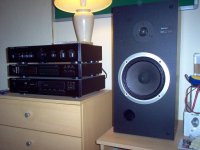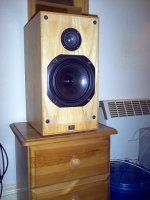silver, micro means 1 millionth of something. 345m/s equals to 345/1,000,000 m/us = 0.000345 m/us, for 22.77 us= 0.007855m=0.7855 cm
thump, people have a clue alright, you're just not willing to converse.
edit: silver, your calculus in post #19 is correct on the left side, only the result was a glitch
thump, people have a clue alright, you're just not willing to converse.
edit: silver, your calculus in post #19 is correct on the left side, only the result was a glitch
Last edited:
Besides, I have the new .frd file from PE so this is all academic. PE will replace the .frd file on their website soon.
I was on the road... but my brain is slow

They have entered a reference point of NOT -0.182m 0.78cm, so this point is NOT far behind the dome !
Last edited:
silver, micro means 1 millionth of something. 345m/s equals to 345/1,000,000 m/us = 0.000345 m/us, for 22.77 us= 0.007855m=0.7855 cm
thump, people have a clue alright, you're just not willing to converse.
I've used an online converter :
Convertir Temps, Microsecondes
22.7µS=2,27×10-5Sec

Last edited:
thump, people have a clue alright, you're just not willing to converse.
No, they don't. Unless you are the person that did the actual measurement AND are aware of what went wrong, (and for some perverse reason, didn't care to correct it) you don't know.
I was never interested in why it was wrong, as everyone else that has commented in MY thread has seemed to try to explain. 6-7db can NOT be explained by any answer given so far that any semi-competent person doing the measurements wouldn't catch. Even PE said they weren't sure, hence my calling all of this here "speculation". If the source isn't sure...............
All I cared about was getting the .frd file correct and the easiest answer to that was a remeasure of the Dayton DC28F-8 driver, which PE has done.
You wanted conversation, Lojzek. Well, there you have it.
- I was never interested in why it was wrong...
- Even PE said they weren't sure...
- All I cared about was getting the .frd file correct and the easiest answer to that was a remeasure of the Dayton DC28F-8 driver, which PE has done.
Well, that wasn't so hard! People got the wrong impression that you were somehow trying to understand what went wrong.
Well, that wasn't so hard! People got the wrong impression that you were somehow trying to understand what went wrong.
"Silverprout" made an assumption and everyone else (particularly you) went with it. Even AFTER I had told you what PE said when you asked.
This wasn't a "conversation" problem but an unwillingness to listen to what I DID say.
"Silverprout" made an assumption and everyone else (particularly you) went with it. Even AFTER I had told you what PE said when you asked.
This wasn't a "conversation" problem but an unwillingness to listen to what I DID say.
😉 Sorry i can't resist... but i must say that your avatar is scary and it has an effect on what you've wrote in front of it (it's stupid but human)
Now i'm not afraid anymore 😀
Thump, thanks for asking this question. Very helpful since I'm using this tweeter as well.
Looking at the impedance graph, would you use a zobel network to smooth out the humps? Would you use a zobel network on a tweeter?
Thanks,
Vince
Looking at the impedance graph, would you use a zobel network to smooth out the humps? Would you use a zobel network on a tweeter?
Thanks,
Vince
Actually, Silverprout, I believe it was your link that drove those that followed down the path they went.
vdi, attached is the Dayton BR-1 modded MurphyBlaster Xover. The BR-1 uses the Dayton DC28F tweet and a DC160-8 woofer. This is just an example. How you will need to tune the xover for the DC28F will depend on what you want out of it as well as what woofer you are using with it.
vdi, attached is the Dayton BR-1 modded MurphyBlaster Xover. The BR-1 uses the Dayton DC28F tweet and a DC160-8 woofer. This is just an example. How you will need to tune the xover for the DC28F will depend on what you want out of it as well as what woofer you are using with it.
Attachments
Just having a bit of fun with you really, THUMP LUMP! 😀
Why would anybody with good ears waste time on some stupid soft-dome tweeter anyway? 😕
Dayton Audio DC28F-8 1-1/8" Silk Dome Tweeter 8 Ohm
Regardless of some established measuring issues by Dayton.
Almost anything else you do will be better.
Why would anybody with good ears waste time on some stupid soft-dome tweeter anyway? 😕
Dayton Audio DC28F-8 1-1/8" Silk Dome Tweeter 8 Ohm
Regardless of some established measuring issues by Dayton.
Almost anything else you do will be better.
Attachments
I use this tweeter and I like it. However, it is not efficient and I'm more likely to believe the 89db curves. When I measure it against a claimed 90db woofer its always 2 db lower although in the higher freq range of course. I don't have a calibrated mic or anechoic chamber so its a relative measurement.Curious at this. PE specs put the SPL at 89db @ 1w/1m where as the FRD graph and FRD file put the SPL around 95+, depending on were you look. What gives?
For an inexpensive tweeter, it does sound great. The old 89db graph is correct and the one that is currently associated with this tweeter (95-96db) is wrong.
Grasshopper, you have much to learn... 
Robin Marshall: A Modicum of Genius | Stereophile.com
Soft-domes produce a facsimile of music, because your Brain makes a correction. It's not the real thing. Once the centre of the dome goes into breakup above 7kHz, they have just lost it completely. IMO. 😀

Robin Marshall: A Modicum of Genius | Stereophile.com
Soft-domes produce a facsimile of music, because your Brain makes a correction. It's not the real thing. Once the centre of the dome goes into breakup above 7kHz, they have just lost it completely. IMO. 😀
Grasshopper, you have much to learn...
Robin Marshall: A Modicum of Genius | Stereophile.com
Soft-domes produce a facsimile of music, because your Brain makes a correction. It's not the real thing. Once the centre of the dome goes into breakup above 7kHz, they have just lost it completely. IMO. 😀
So........ you're one of those. You let specs and measurement make up your mind as to how something sounds and not your ears.
OK........Pick another tweeter, UNDER $20.00 (U.S. Dollars and not that stuff you use), that sounds better.
I suppose you also think that everyone should listen to one type of music because it's, in your opinion, sonically correct?
I'll ignore that fact that you obviously missed were I said "For an inexpensive tweeter"
Just wondering.....have you ever come close to drowning when it rains????
Last edited:
You DO realize that most of the music recorded in the last 30+ years has been mixed and mastered with Yamaha NS-10 monitors? They just also just happen to have soft dome tweets.
But I guess all these guys doing all this mixing and mastering of all this music don't know squat about what music should sound like.
https://en.wikipedia.org/wiki/Yamaha_NS-10
But I guess all these guys doing all this mixing and mastering of all this music don't know squat about what music should sound like.
https://en.wikipedia.org/wiki/Yamaha_NS-10
Actually, Thump Lump, soft domes measure beautifully. Except, if you are really measuring the right thing, on the waterfall of stored energy and phase. Just that they sound like dreck, IMO. Spitty and overly bright. The Yamaha NS-10 was a popular monitor, because it represented what most people were listening to.
I did a rather sophisticated Acoustic Butterworth filter for my Morel CAT 298 soft dome. It still made my ears bleed! 😱
More recently I listened to Robin Marshall and tried cone tweeters, which cost about $10. Here the Monacor HT-22. Some dispersion issues, but very musical. And I could do something about the very top end dispersion with a supertweeter. I don't mind mylar domes either.
I'm also happy enough with metal domes too. SB Acoustics and Vifa Ring-radiators might be a future project. They have theoretical strengths, but were not around in Robin's day. Who knows about Beryllium...
The fact is, with soft-domes, is you always spend a lot of time reducing their output to make them bearable. Well, maybe there's a better way. Ditch them altogether. But don't let me stop you wasting time on them. 🙂
I did a rather sophisticated Acoustic Butterworth filter for my Morel CAT 298 soft dome. It still made my ears bleed! 😱
More recently I listened to Robin Marshall and tried cone tweeters, which cost about $10. Here the Monacor HT-22. Some dispersion issues, but very musical. And I could do something about the very top end dispersion with a supertweeter. I don't mind mylar domes either.
I'm also happy enough with metal domes too. SB Acoustics and Vifa Ring-radiators might be a future project. They have theoretical strengths, but were not around in Robin's day. Who knows about Beryllium...
The fact is, with soft-domes, is you always spend a lot of time reducing their output to make them bearable. Well, maybe there's a better way. Ditch them altogether. But don't let me stop you wasting time on them. 🙂
Attachments
Last edited:
No need to be condescending or snide. It won't help or further your case.Grasshopper, you have much to learn...
Robin Marshall: A Modicum of Genius | Stereophile.com
Soft-domes produce a facsimile of music, because your Brain makes a correction. It's not the real thing. Once the centre of the dome goes into breakup above 7kHz, they have just lost it completely. IMO. 😀
Dome breakup and resonances are certainly there for anything mechanical. The question is, "do you have an independant test report for this DC28F". Secondly, is it important to liking the tweeter when you listen to it.
I have many tweeters : silk soft dome, poly soft dome, Al-Dome, and Ti-Dome tweeters and I prefer the soft dome.
As for the article link. Its just an interview with a guy who claims to have invented the metal dome tweeter arguing as to why it's superior to soft domes. Somewhat biased. I'm not from Missouri, but I certainly understand them.
Don, whatever I say to Thump Lump, I'm going to come over as more polite than him. N'est pas? 😀
Most people wouldn't know a phase plot from a hole in the ground IME, though they tell me a lot about stored energy. But here's a waterfall by Troels Gravesen of a 3" soft dome ATC mid. Some horrors there above 4.5kHz. A smaller 1.125" tweeter is going to do the same thing at a higher frequency.
With science, it is best to leave your ego outside the door. Because the science always wins. 😎
Most people wouldn't know a phase plot from a hole in the ground IME, though they tell me a lot about stored energy. But here's a waterfall by Troels Gravesen of a 3" soft dome ATC mid. Some horrors there above 4.5kHz. A smaller 1.125" tweeter is going to do the same thing at a higher frequency.
With science, it is best to leave your ego outside the door. Because the science always wins. 😎
Attachments
I'm still waiting for science to appear.Don, whatever I say to Thump Lump, I'm going to come over as more polite than him. N'est pas? 😀
Most people wouldn't know a phase plot from a hole in the ground IME, though they tell me a lot about stored energy. But here's a waterfall by Troels Gravesen of a 3" soft dome ATC mid. Some horrors there above 4.5kHz. A smaller 1.125" tweeter is going to do the same thing at a higher frequency.
With science, it is best to leave your ego outside the door. Because the science always wins. 😎
We are talking about this particular 28mm soft dome. Do you have a test report? I'm sure all physical devices have mechanical resonances. Are they relevant? Even in the same class of device there can be huge variation in performance. Presenting one graph of a 75mm soft dome and claiming it is relevant to all soft domes of all sizes everywhere on the planet is not science. You are extrapolating from a single data point.
I have an open mind, I'm just asking for proof, and I have not seen it.
- Home
- Loudspeakers
- Multi-Way
- Dayton DC28f discrepancy?





